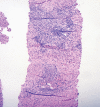Autoimmune Hepatitis with Distal Renal Tubular Acidosis and Small Bowel Partial Malrotation
- PMID: 29201703
- PMCID: PMC5578537
- DOI: 10.5005/jp-journals-10018-1145
Autoimmune Hepatitis with Distal Renal Tubular Acidosis and Small Bowel Partial Malrotation
Abstract
Renal tubular acidosis (RTA) is not uncommon in patient with chronic autoimmune hepatitis (AIH), but usually remains latent. Here, we report a case of renal tubular acidosis RTA who presented with AIH. She was also diagnosed to have partial bowel malrotation. A 9-year-old girl, a case of distal RTA, presented with jaundice, abdominal distension and altered sensorium. She was diagnosed to be AIH, which was successfully treated with steroids and azathioprine. Coexistent midgut partial malrotation with volvulus was diagnosed during the treatment. She was treated successfully with anti-tuberculous treatment for cervical lymphadenitis. Autoimmune hepatitis should not be ruled out in each case of RTA presenting with jaundice.
How to cite this article: Modi TK, Parikh H, Sadalge A, Gupte A, Bhatt P, Shukla A. Autoimmune Hepatitis with Distal Renal Tubular Acidosis and Small Bowel Partial Malrotation. Euroasian J Hepato-Gastroenterol 2015;5(2):107-109.
Keywords: Autoimmune hepatitis; Malrotation; Renal tubular acidosis..
Conflict of interest statement
Source of support: Nil Conflict of interest: None
Figures




Similar articles
-
Pediatric Sjogren syndrome with distal renal tubular acidosis and autoimmune hypothyroidism: an uncommon association.CEN Case Rep. 2015 Nov;4(2):200-205. doi: 10.1007/s13730-015-0169-y. Epub 2015 Feb 19. CEN Case Rep. 2015. PMID: 28509102 Free PMC article.
-
Meta-Analysis and Systematic Review of Primary Renal Tubular Acidosis in Patients With Autoimmune Hepatitis and Alcoholic Hepatitis.Cureus. 2021 May 28;13(5):e15287. doi: 10.7759/cureus.15287. Cureus. 2021. PMID: 34079685 Free PMC article. Review.
-
Distal Renal Tubular Acidosis Associated with Celiac Disease and Thyroiditis.Indian Pediatr. 2016 Nov 15;53(11):1013-1014. doi: 10.1007/s13312-016-0978-x. Indian Pediatr. 2016. PMID: 27889732
-
Renal tubular acidosis secondary to FK506 in living donor liver transplantation: a case report.Asian J Surg. 2003 Oct;26(4):218-20. doi: 10.1016/S1015-9584(09)60307-9. Asian J Surg. 2003. PMID: 14530108
-
Renal tubular acidosis presenting as respiratory paralysis: report of a case and review of literature.Neurol India. 2010 Jan-Feb;58(1):106-8. doi: 10.4103/0028-3886.60415. Neurol India. 2010. PMID: 20228475 Review.
Cited by
-
Acute Kidney Injury Induced by Immune Checkpoint Inhibitors.Kidney Dis (Basel). 2022 Apr 4;8(3):190-201. doi: 10.1159/000520798. eCollection 2022 May. Kidney Dis (Basel). 2022. PMID: 35702709 Free PMC article. Review.
-
Delayed Presentation of Malrotation after Infancy: A Systematic Review Based on Clinical Presentations, Associated Anomalies, Diagnosis, and Management.J Indian Assoc Pediatr Surg. 2024 Sep-Oct;29(5):417-434. doi: 10.4103/jiaps.jiaps_105_24. Epub 2024 Aug 23. J Indian Assoc Pediatr Surg. 2024. PMID: 39479428 Free PMC article. Review.
References
-
- Karet FE. Disorders of water and acid-base homeostasis. Nephron Physiol. 2011;118(1):28–34. - PubMed
-
- Toblli JE, Findor J, Sorda J, Bruch Igartua E, Hasenclever K, Collado HD. Latent distal renal tubular acidosis (dRTA) in primary biliary cirrhosis (PBC) and chronic autoimmune hepatitis (CAH). Acta Gastroenterol Latinoam. 1993;23(4):235–238. - PubMed
-
- Mieli-Vergani G, Heller S, Jara P et al. Autoimmune hepatitis. J Pediatr Gastroenterol Nutr. 2009;49(2):158–164. - PubMed
Publication types
LinkOut - more resources
Full Text Sources
Other Literature Sources
